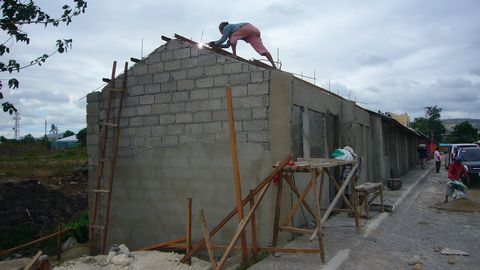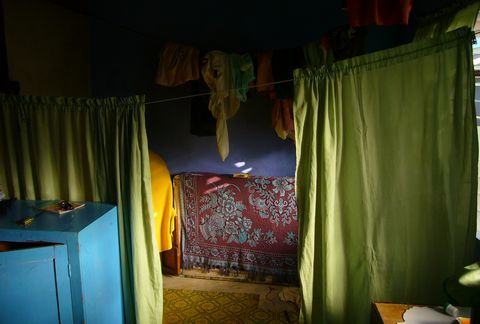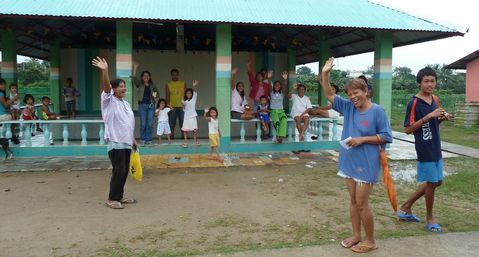| But first, a little flashback to last year. | |
| GK is a refuge for poor people who need homes. Concrete 1-room row houses financed by donations provide high-density shelter for families large and small. Each home is about 20 ft. x 20 ft. | |
 In 2010, some homes were still under construction, but many were completed. |
 |
|
The fronts of the homes (above right) face a wide alleyway
divided by a planter, whereas the backs of the homes faces muddy narrow
unpaved alleyways (right) where laundry dries slowly in the humid air. We explained vasectomy to Angela (above right), who had had 11 children, with hopes that she would inspire her husband to come for a vasectomy later that day when he returned from work as a putt-putt (bicycle with a passenger seat) driver. Some tenants managed to procure a few wood panels to create a barrier between the living area and the one "bedroom", but most just hung a curtain. If there was a bed, it was tiny. Most tenants just slept on thin blankets or mats. |
 |
 |
 There were some electronics, but electricity was sporadic and many electronics did not work and seemed to be retained more as ornaments than for their functional value. No units had running water, so tenants made regular trips to the community well, and a few units (below left) had old water coolers to serve as storage receptacles for the well-water. |
 |
 Children were everywhere. Here they feast hungrily on some plain bread that we purchased from a vendor during our visit. |
| Most families had 4 or more
children. Angela's family had 11 children all living and sleeping in her
tiny home. We left the women of GW with an open invitation to send their husbands to the nearby hospital for vasectomies, simple procedures that would provide more control over their family sizes. They explained that their husbands might refuse for fear of pain or loss of sexual function, but when we mentioned that we were offering each man $20 US to cover transportation costs and 2 days of lost income, their eyes brightened. |
|
 While we were visiting GW, our support staff was busy orienting the staff and counseling the patients. By the time we arrived, the men were waiting. |
 |
 We quickly went to work, 3 NSVI surgeons sharing 3 tables in a single operating room. |
 |
|
After their procedures, some patients were kind enough (and proud
enough!) to pose for a group photo. They were also delighted to receive $20. For some men, that's 2 weeks' pay. |
|
 |
 |
| The nursing staff and students were also delighted with the photo op and the hospital director (blue/green top) was pleased to have offered his facility as a site for such a productive mission. | |
 |
Later that day we returned to Gawad Kalinga.
Angela was still holding her newborn baby and was proud of her husband
(red shirt) for having his vasectomy earlier that day. He was feeling
just fine! So for them, 11 it will be. No more. An opportunity to focus on and nurture the children that they already have, and to enjoy sex without fear of another pregnancy, which, at this point, could pose a serious risk to her health. |
| Now, back to 2011: | |
| We returned to Gawad Kalinga one year later, this time with the filmmakers who are preparing a documentary on Male Involvement in Family Planning and World Population Issues. It was a weekday and the men were off working, some locally, some overseas. | |
 |
 |
| Angela was still there, but this time without a newborn, and she wasn't pregnant again! | Now she had time to tend her own garden. |
 |
 |
| Community leader Juanita (blue
shirt) also brought us to see Anita (pink shirt) ... |
... and Malinda, all of whose husbands had undergone vasectomy by us last year. Malinda had had 3 children and her one room living area looked like a school room with a little worktable and ABCs on a bulletin board (I wish I had taken a photo). |
 |
 |
| And there was a 4th young mother (4 children, green shirt) whose husband had opted for vasectomy last year. | They were all so pleased with the freedom granted by their husbands vasectomies. Other women asked if their husbands could have vasectomies. |
 |
 |
| Since we were not using the nearby hospital in Talisay this year, arrangements were made by Juanita for us to perform vasectomies in the recreation room of GK, but the proposal was stifled by Couples For Christ, an organization with a big influence in the community. | We felt good for the children whose parents could now be focused more on them than on competing younger siblings. |
 |
 |
| One last photo (myself, social worker/vasectomy promoter Frohnie, flimmaker Jonathan Stack, vasectomy provider Dr. Ronald Suarez, filmmaker Saralena Weinfield, vasectomy provider and NSVI President Dr. Ramon Suarez) ... | ... before a huge Good-Bye from the families of GK, the most grateful recipients of NSVI Free Vasectomy Services in the Philippines. |
After such a warm reception, you can imagine our disappointment when we
learned later that morning that goverment agents, influenced by religious
leaders, had stifled our efforts to increase public awareness of our annual
NSVI-sponsored Free Vasectomy Program.
Read on.
|
Title
Page NSVI 2011 Mission |
Day 1 Arrival Vasectomies at Sacred Heart Hospital |
Day 2 Billboards and Politics |
Day 2 Gawad Kalinga |
Day 5 Lectures at SWU Medical School Vasectomies at Visayas Community Medical Center |
Day 8 107 vasectomies at Sacred Heart Hospital |